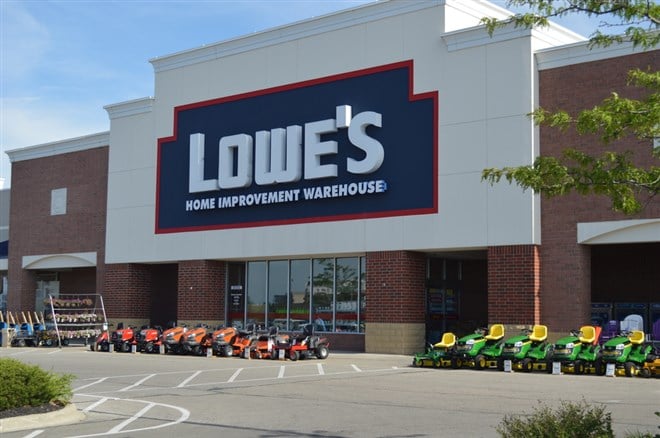
Indeed, we're not "past" the pandemic (you can probably name a couple of people you know who have had positive COVID-19 tests — they continue to bubble up). If you've been a trader or investor over the past two years, you likely noticed a giant leap in Lowe's stock. Consumers had a huge drive to buy comfort during the pandemic in the form of updating their homes. Digital sales experienced explosive growth to the tune of 106% year over year growth.
Home improvement stores like Lowe's Companies Inc. (NYSE: LOW) and The Home Depot Inc. (NYSE: HD) pretty much obliterated local hardware stores in the same way that Amazon put pressure on bookstores. Whether you're a contractor or homeowner, you can find what you need at Lowe's, and investors may also find out what they need as well. Since the company went public in 1961, the home-improvement retailer has increased its dividend increase track record.
According to Lowe's, more than half of the homes in the U.S. are over 40 years old, and those built in the housing boom of the 2000s will turn 20 years old. Aging homes may encourage Americans to want to pop in the money to repair their homes.
However, it's worth considering that the home improvement retailer lowered its sales outlook for 2022 after Q2 revenue declines. Amid all of these circumstances, let's take a look at the information you may want to know about Lowe's Companies Inc., as well as the pros and cons you may want to consider before you sink some money into this dividend stock.
About Lowe's Companies Inc.
Lowe's Companies Inc., headquartered in Mooresville, North Carolina, is a home improvement retailer in the United States and internationally. The company offers the following products for construction, maintenance, repair, remodeling, and decorating:
- Home improvement products
- Appliances
- Seasonal and outdoor living
- Lawn and garden
- Lumber
- Lighting
- Kitchens and bath
- Tools
- Paint
- Hardware
- Flooring
- Plumbing
- Building materials
- Décor
The company also offers extended protection plans as well as in-warranty and out-of-warranty repair services, merchandise and private brand products through Lowes.com and Lowesforpros.com.
Lowe's Company Inc. reported net earnings of $3 billion, diluted earnings per share (EPS) of $4.67 in Q2 compared to diluted EPS of $4.25 in 2021 Q1. The company also reported earnings of $27.5 billion in 2022 Q2 compared to $27.6 billion in Q2 of 2021, a decrease of 0.3%. In contrast, the U.S. home improvement business increased 0.2% in Q2 of 2022.
Pros and Cons of Investing in Lowe's Companies Inc.
What are the pros and cons of investing in Lowe's Companies Inc.? In addition to reading through a few of the pros and cons, it's a good idea to put together your own list of benefits and downsides of investing in Lowe's Companies Inc.
Pros
Let's walk through some of the benefits of considering an investment in Lowe's Companies Inc. It can help you decide whether or not to go for the big buy-in.
- Earnings: Lowe's gross profit margin held steady 33% even in the face of increasing costs. Operating income rose to 15.4% of sales in comparison to 15.3% of sales in 2021.
- Dividends: Lowe's Companies Inc. is a Dividend Aristocrat, which is a company that is part of the S&P 500 index that not only consistently pays dividends, but regularly increases the size of its payouts. The annual dividend of $4.20, dividend increase track record of 48 years, 2.17% dividend yield, 33.10% dividend payout ratio, and annualized three-year dividend growth rate of 17.49%.
Cons
Take a look at the downsides before you choose to invest in Lowe's Companies Inc.:
- Weak sales: This time around, Lowe's Companies Inc. announced in Q2 that it had flat earnings and falling sales. Total sales in 2022 were $27.5 billion compared to $27.6 billion compared to Q2 2021, and comparable sales decreased 0.3%. The company also announced a downed outlook when revenue declined at that point. Investors who follow both Lowe's Companies Inc. and compare it to The Home Depot may notice quickly that in this light, between the two companies, The Home Depot has a much more shiny outlook compared to The Lowe's Companies.
- Net income decreases: For the three-month period ended July 29, Lowe’s reported a net income of $2.99 billion, down from $3.02 billion last year. Net sales slipped to $27.48 billion, from $27.57 billion a year ago.
- Potentially better competition: The Home Depot currently has a consensus target price of $365.95, showing a potential upside of 29.96%. Lowe's Companies, on the other hand, has a consensus target price of $244.05, which indicates a potential upside of 24.66%. The Home Depot's higher consensus rating and higher probable upside means that equity analysts consider Home Depot to be more favorable than Lowe's Companies.
Learn more: 11 Dividend Stocks with High Yield
Does Lowe's Companies Inc. Offer a Boost?
Lowe's Companies Inc. was one of the most successful companies during the pandemic amid a raft of other companies that rode the struggle bus during the pandemic. Pandemic-induced sales benefited Lowe's due to a large spate of U.S. do-it-yourself and decorating projects, including additions to homes, remodels and appliance switcheroos.
Stock prices rose a staggering 150% during the height of the pandemic and have since suffered a pullback, including declining sales, net income decreases as well as competitive challenges.
How do you know which are the best dividend stocks to your portfolio? Consider your goals, investment timeline, risk tolerance and the other types of investments you have in your portfolio. You may also want to consider the diversification of your current portfolio. The types of investments you already have may guide you toward making the right choices.
Learn more: How to Buy an ETF for Dividend Stock Returns: What You Need to Know




